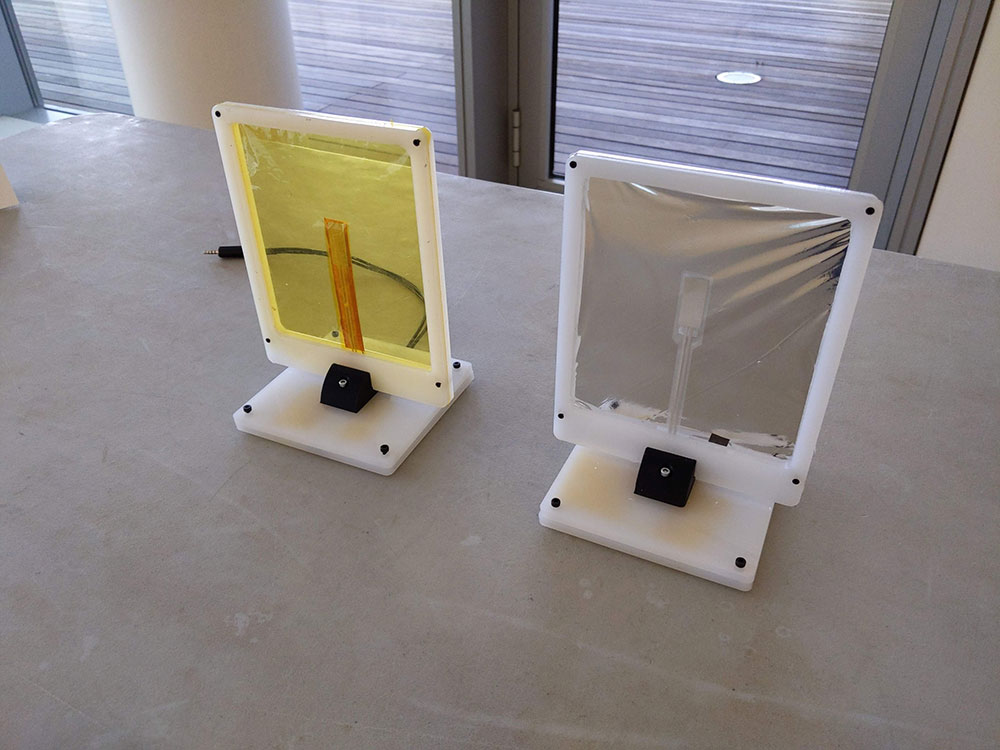Thin Film Microphone
I decided to explore a final project that is closer to my TMG research topic. At TMG I have been exploring how to embed piezoelectrics in thin sheets (paper, mylar, PET film) turning them into vibro-acoustic surfaces that have the capability to act like a vibration sensor, microphone and even ultrasonic imaging device.
Based on this idea as my final project I want to create a thin film that can be a bidrectional vibration input/output device. A material that has the capability to 'hear' and 'speak'.
I want my final device to be simply a piece of sheet material, either paper or thin film that can be used to record and playback audio (sheet input and output). Ideally even the electronics should be embedded into the material (directly having the electronics glued to paper with circuit printed).
The final interaction of my project will be to have two pieces of sheet material (ideally paper), one as an acoustic sensor and one as an acoustic speaker. You speak into one and your voice can be heard into the other. For this I have split my project in multiple components.
Use the links above to navigate through in depth documentation of the project.
Making Of
Demo Video
Access project files here:
Thin Film Microphone Source FilesProject Components
Thin film microphones embedded in stand, to read more about the making of go to sensor page,stand and enclosure page.

Analog and digital board for signal conditioning, to learn more go to programming page,electronics page and interface page.

Project Answers
- What does it do?
- Who's done what beforehand?
- What did you design?
- What materials and components were used?
- Where did they come from?
- How much did they cost?
- LDT PiezoElectric Sensor: $23.00
- AD8226 OpAmp: $5.00
- TLV2473 OpAmp: $2.00
- SAMD11 Microcontroller: $1.20
- What parts and systems were made?
- Electromics board (design, mill and solder)
- Microphone film (lamination)
- Microphone frame + stand (3D printing, laser cutting
- Circuit Enclosure(3D printing, laser cutting
- What processes were used?
- What questions were answered?
- How was it evaluated?
- What are the implications?
I built a sensitive microphone out of piezoelectric thin film and mylar. I used analog electronics to condition the signal from the piezoelectric sensor (noise filtering, amplification and sampling) and created the prototype of thin film microphones.
There has been work in using piezoelectric sensors as contact microphones in music production and in HCI (for touch detection and localization). Crystal microphones are also well known and common in music production. This project proposes a new approach by creating thin film sheets that have piezoelectric sensors with high sensitivity and flat frequency response.
I designed a analog / digital circuit board to condition the signal of the piezoelectric sensor, a pipeline for sampling and aquiring the signal using a SAMD11 microcontroller. An interface to visualize the sound in real time well as a stand and enclosure to package the demo.
To build this project I used SRM-20 PCB Milling machine with Mods software. I designed the boards in Eagle and used ICs from different suppliers (AD8226, TLV2374, SAMD11). The board enclosure was deigned in Fusion and 3D Printed in a Prusa FDM printer. The piezoelectric sensors were sourced directly from Measurements Specialities (I attempted printing my own piezoelectric sensors during input week but the attempts failed to give a good response). The film stand was designed in Fusion and laser cut.
Most of the components for the board were sourced from Digikey, printing filament and perspex for stand were provided by my department.
The bulk of the spend on my project is around the sensor, op amps and microcontroller, the rest of the materials for the frame, enclosure and thin film were sourced from scraps in Media Lab.
For conditioning the signal I designed and built an analog electronic circuit with gain and filter stages, for sampling I implemented a ADC using SAMD11 chip. For the fabrication of the board I used milling machine and hand soldering. For the fabrication of the sensor I used thin lamination. For the fabrication of the stands I used 3D printing and laser cutting.
My main question was, could I create a microphone embedded in thin film sheet. Although my experiments to actually print the sensor on to thin film failed, the off the shelf sensor demonstrates that thin film microphones are possible to be built and it's a very strong pointer to the next step in my research that is to focus on the sensor printing.
My main goals for evaluating the sensor were: sensibility, signal to noise ration and frequency response. I didn't do any formal characterization of the sensor given time constraints but I am pretty satisfied with the result, the sensor sounds very flat in frequency response, I can make it incredibly sensible by tweaking the gains and I managed to get rid of almost all noise due to shielding, filtering strategy on electronics and running of the sensor from a battery
This project demonstrates that we can use thin sheet material for acoustic sensing in space, given it's form factor and possibility of printing the acoustic sensor directly into the material it builds on research in acoustic sensing by contributing with 'thin film' approach to building large microphone arrays.